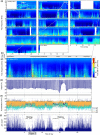Long-term sound and movement recording tags to study natural behavior and reaction to ship noise of seals
- PMID: 30891202
- PMCID: PMC6405890
- DOI: 10.1002/ece3.4923
Long-term sound and movement recording tags to study natural behavior and reaction to ship noise of seals
Abstract
The impact of anthropogenic noise on marine fauna is of increasing conservation concern with vessel noise being one of the major contributors. Animals that rely on shallow coastal habitats may be especially vulnerable to this form of pollution.Very limited information is available on how much noise from ship traffic individual animals experience, and how they may react to it due to a lack of suitable methods. To address this, we developed long-duration audio and 3D-movement tags (DTAGs) and deployed them on three harbor seals and two gray seals in the North Sea during 2015-2016.These tags recorded sound, accelerometry, magnetometry, and pressure continuously for up to 21 days. GPS positions were also sampled for one seal continuously throughout the recording period. A separate tag, combining a camera and an accelerometer logger, was deployed on two harbor seals to visualize specific behaviors that helped interpret accelerometer signals in the DTAG data.Combining data from depth, accelerometer, and audio sensors, we found that animals spent 6.6%-42.3% of the time hauled out (either on land or partly submerged), and 5.3%-12.4% of their at-sea time resting at the sea bottom, while the remaining time was used for traveling, resting at surface, and foraging. Animals were exposed to audible vessel noise 2.2%-20.5% of their time when in water, and we demonstrate that interruption of functional behaviors (e.g., resting) in some cases coincides with high-level vessel noise. Two-thirds of the ship noise events were traceable by the AIS vessel tracking system, while one-third comprised vessels without AIS.This preliminary study demonstrates how concomitant long-term continuous broadband on-animal sound and movement recordings may be an important tool in future quantification of disturbance effects of anthropogenic activities at sea and assessment of long-term population impacts on pinnipeds.
Keywords: DTAG; anthropogenic noise; behavioral response; biologging; exposure rates; gray seal; harbor seal; long‐duration acoustic dataloggers.
Conflict of interest statement
None declared.
Figures







References
-
- Aguilar Soto, N. , Johnson, M. , Madsen, P. T. , Tyack, P. L. , Bocconcelli, A. , & Fabrizio Borsani, J. (2006). Does intense ship noise disrupt foraging in deep‐diving Cuvier's beaked whales (Ziphius cavirostris)? Marine Mammal Science, 22, 690–699.
-
- Andersen, S. M. , Teilmann, J. , Dietz, R. , Schmidt, N. M. , & Miller, L. A. (2012). Behavioural responses of harbour seals to human‐induced disturbances. Aquatic Conservation: Marine and Freshwater Ecosystems, 22, 113–121. 10.1002/aqc.1244 - DOI
-
- Andersen, S. M. , Teilmann, J. , Dietz, R. , Schmidt, N. M. , & Miller, L. A. (2014). Disturbance‐induced responses of VHF and satellite tagged harbour seals. Aquatic Conservation: Marine and Freshwater Ecosystems, 24, 712–723. 10.1002/aqc.2393 - DOI
-
- Arcalís‐Planas, A. , Sveegaard, S. , Karlsson, O. , Harding, K. C. , Wåhlin, A. , Harkonen, T. , & Teilmann, J. (2015). Limited use of sea ice by the Ross seal (Ommatophoca rossii), in Amundsen Sea, Antarctica, using telemetry and remote sensing data. Polar Biology, 38, 445–461. 10.1007/s00300-014-1602-y - DOI
-
- Blackwell, S. B. , Lawson, J. W. , & Williams, M. T. (2004). Tolerance by ringed seals (Phoca hispida) to impact pipe‐driving and construction sounds at an oil production island. The Journal of the Acoustical Society of America, 115, 2346–2357. - PubMed
Associated data
LinkOut - more resources
Full Text Sources
Other Literature Sources
Molecular Biology Databases

